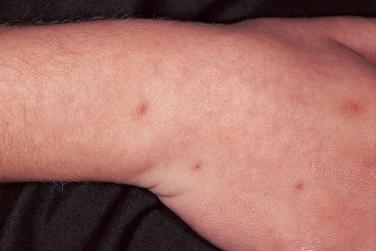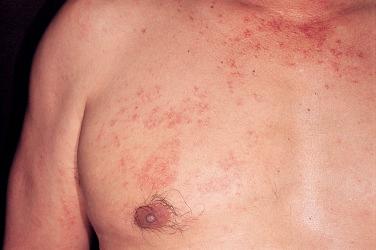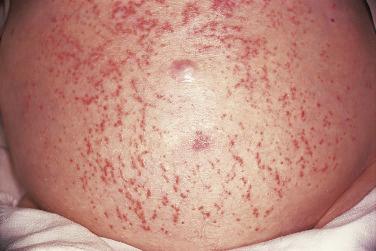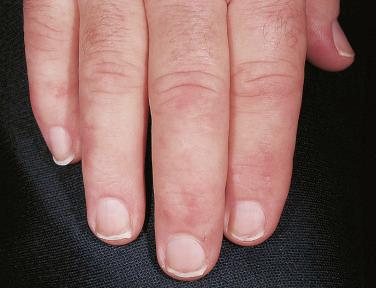Physical Address
304 North Cardinal St.
Dorchester Center, MA 02124
The cutaneous changes of hepatic disease may be related to primary diseases of the liver, cutaneous diseases with associated hepatic abnormalities, disorders with changes in many organs, including the liver and skin, and medications with direct effects on the liver or indirect effects due to hypersensitivity reactions.
Pruritus or prurigo nodularis without an identifiable cutaneous eruption warrant an investigation for hepatic disease.
The dermatologic stigmata of cirrhosis include jaundice, spider angiomas and other telangiectases, palmar erythema, dilated abdominal wall veins, nail changes including Terry nails, and thinning of the body hair, among others.
Primary biliary cirrhosis, which occurs most frequently in women 40 to 60 years of age, is recognized by a combination of pruritus, jaundice, hyperpigmentation, and xanthomas.
Hemochromatosis and Wilson’s disease are autosomal recessive disorders that affect the liver and may present with skin or ocular findings, including a metallic gray or brown hyperpigmentation in the former and a pathognomonic golden-brown or green-brown pigmentation of the corneal margins in the latter.
Both viral hepatitis and the therapies used to treat these diseases may cause a multitude of cutaneous eruptions.
A number of cutaneous stigmata are associated with hepatic disease, but none are specific. Even jaundice, classically associated with liver immaturity (neonatal jaundice) or failure, may occur with hemolysis and in the setting of perfectly normal hepatic function. The cutaneous changes of hepatic disease may be related to primary diseases of the liver; to cutaneous diseases with associated hepatic abnormalities; and to a wide variety of disorders with changes in many organs, including the liver and skin. A number of systemically administered drugs commonly used for the treatment of cutaneous disease may produce hepatic damage, including methotrexate, ketoconazole, itraconazole, terbinafine, retinoids, and vitamin A. Finally, several drugs produce hypersensitivity reactions characterized by fever, lymphadenopathy, eosinophilia, hepatitis, and cutaneous eruptions, which can result in severe liver damage. This drug reaction has been known by various terms, but most commonly is referred to as d rug r eaction with e osinophilia and s ystemic s ymptoms (DRESS). Drugs in this category include phenytoin, phenobarbital, carbamazepine, dapsone, minocycline, and allopurinol, among others (see Chapter 47 ).
Classically, cutaneous manifestations have been associated with primary hepatic diseases including alcoholic cirrhosis and hemochromatosis, but other disorders, including Wilson’s disease, viral hepatitis, and primary biliary cirrhosis, have associated cutaneous findings. Porphyria cutanea tarda and erythropoietic protoporphyria, known primarily for their cutaneous manifestations, are associated with hepatic abnormalities (see Chapter 28 ). Patients with porphyria cutanea tarda have frequently been found to have hepatitis C virus infection. Gianotti–Crosti syndrome was originally thought to be associated with viral hepatitis, but this association may be more prevalent only in southern Europe. Lichen planus, particularly oral lichen planus, has also been associated with hepatitis C infection. Miscellaneous diseases that affect many organ systems and involve the liver and the skin include syphilis, sarcoidosis, Gaucher’s disease, polyarteritis nodosa, and cytophagic histiocytic panniculitis. Many of these disorders are discussed elsewhere in this book, and others occur too infrequently to be discussed in detail here.
Cutaneous symptoms, such as pruritus and jaundice, may be important evidence for considering the diagnosis of hepatic disease, especially in conjunction with nonspecific symptoms such as fatigue, anorexia, vomiting and weight loss, diminished libido, and right upper quadrant abdominal discomfort. In addition to these symptoms, certain physical findings, especially when considered collectively, suggest the diagnosis of hepatic disease. Mucocutaneous lesions are often prominent and include scleral icterus, spider telangiectases, palmar erythema, excoriations (e.g., neurotic excoriations and prurigo nodularis), xanthelasma, alopecia, nail lesions, gynecomastia, and prominence of the cutaneous veins in the epigastrium. Any patient with symptoms of pruritus and/or findings of neurotic excoriations or prurigo nodularis ( Fig. 30-1 ) in the absence of a primary cutaneous disease should be evaluated for liver disease.
Cirrhosis of the liver implies an irreversible alteration of the liver’s architecture, consisting of hepatic fibrosis, areas of nodular regeneration, and a loss of a considerable number of hepatocytes. Although alcohol is one of the most common causes of cirrhosis (Laënnec’s cirrhosis) in the United States, cirrhosis can be caused by drugs and other toxins including acetaminophen; infections (especially hepatitis C virus); biliary obstruction (e.g., carcinoma of the pancreas or bile duct, gallstones, cystic fibrosis); metabolic diseases (e.g., hemochromatosis and Wilson’s disease); chronic right-sided congestive heart failure; and a group of miscellaneous diseases such as sarcoidosis, primary biliary cirrhosis, and jejunoileal bypass. There are also a number of cases of cirrhosis that are idiopathic. Individuals with cirrhosis usually present in one of two general ways, i.e., (1) with evidence of acute hepatocellular necrosis with jaundice; or (2) with evidence of the complications of cirrhosis, brought on primarily by the rise in intrahepatic vascular resistance and subsequent portal hypertension (i.e., ascites, splenomegaly, bleeding varices, and encephalopathy). Not infrequently, patients present with a mixed picture of these two pathophysiologic pathways.
The dermatological stigmata of cirrhosis are well recognized and include changes in the skin, nails, and hair. Vascular lesions are common and include spider angiomas and other telangiectases; palmar erythema; and dilated abdominal wall veins, which occur in patients with portal hypertension and represent the development of portal systemic collaterals ( Figs 30-2 to 30-4 ). Spider angiomas occur in a majority of patients with cirrhosis, but they are not pathognomonic of the disease because they occur commonly in young children, pregnant women, and otherwise healthy adults. They are so named because of their central pulsatile arterial punctum with radiating branching vessels. They occur almost exclusively on the upper half of the body, especially on the face, neck, and upper trunk. The spider is formed by a coiled arteriole that spirals up to a central point and then branches out into thin-walled vessels that merge with normal capillaries. The pathogenesis of these vascular lesions is unknown, but they do not appear to be related to portal hypertension, which is responsible for one of the most serious complications of cirrhosis: bleeding esophageal and gastric varices. They may be related to excess estrogen, which occurs as a result of reduced hepatic metabolism of estrogens. Palmar erythema, manifested as diffuse or splotchy erythema on the thenar and hypothenar eminences and tips of the fingers, frequently accompanies the development of the spider angiomas. Palmar erythema also occurs in healthy individuals and in association with nonhepatic diseases including human immunodeficiency virus. There may be a widespread appearance of thin, wiry telangiectases in some patients, and occasionally the lesions appear in a unilateral distribution (see Fig. 30-3 ).



Various forms of nail disease have been described in patients with cirrhosis, including the classic white nails described by Terry. Terry nails are characterized by a nail plate that is opaque white with the exception of the distal portion, which retains its normal pink color ( Fig. 30-5 ). In addition, patients may develop transverse white bands (Muehrcke nails), clubbed nails, or koilonychia (spoon-shaped nails), but none of these changes is specific for hepatic disease. Changes in body hair are common and are noted primarily in men. The axillary, pubic, and pectoral hair is usually sparse, but thinning of all body hair is also common. There is often the development of a female pubic hair pattern, coinciding with other evidence of feminization, including testicular softening and gynecomastia. This is in contrast to the hypertrichosis seen in patients with porphyria cutanea tarda and liver disease.

There are a number of nonspecific systemic symptoms associated with cirrhosis of the liver, including weakness, anorexia, nausea, weight loss, and abdominal discomfort. Pruritus is less common in patients with intrahepatic cholestasis and occurs more often in diseases such as primary biliary cirrhosis, sclerosing cholangitis, and chronic extrahepatic biliary obstruction. The cirrhotic liver is usually small, firm, and nodular, and the spleen is often enlarged. Ascites may cause a remarkable distension of the abdominal cavity. Low albumin occurs in the setting of chronic hepatic dysfunction and results in edema, especially of the lower extremities. This can lead to stasis dermatitis and xerosis of the skin in areas of chronic edema. As a result of impaired hepatic function, a prothrombin deficiency may develop, resulting in cutaneous purpura, epistaxis, and gingival bleeding. This deficiency also causes difficulty in controlling the bleeding from varices. The use of intramuscular vitamin K to help reverse the prothrombin deficiency has led to rare reports of unusual annular erythematous reactions surrounding the injection site.
A review of the diagnosis, course, treatment, and prognosis of cirrhosis is beyond the scope of this book. There is, however, one additional point concerning cirrhosis that is especially important for dermatologists, and this is the potential inducement of the disease with methotrexate used to treat psoriasis or other dermatologic conditions. Methotrexate-induced hepatic changes are now believed to be more associated with obesity that is often present in patients with psoriasis. They are also more likely with increasing dosage and duration of therapy. Cirrhosis is unusual in patients treated with methotrexate who do not have other risk factors for hepatic disease. Factors that increase the propensity for cirrhosis in patients taking methotrexate include obesity, steatohepatitis, diabetes mellitus, hyperlipidemia, hepatitis A, B, or C, concomitant potentially hepatotoxic medications such as acetaminophen, statins, systemic antifungals, and/or excessive alcohol intake. It has been suggested that in the absence of other risk factors, patients on methotrexate may not need liver biopsies. Several guidelines exist for the decision to perform a liver biopsy, but recently, noninvasive techniques have been used more frequently to follow patients receiving long-term methotrexate therapy. Levels of the amino terminal peptide of type III procollagen have been used extensively in Europe, particularly the United Kingdom, for evaluation of the liver in order to detect early fibrosis, but this test is not readily available in the United States. There are two tests, known as the Fibrosure for hepatitis C and Fibrosure for steatohepatitis, which are used to follow patients with either disorder. The Fibrosure for steatohepatitis might prove useful in following patients on methotrexate, but this is not currently an FDA-approved use. There are several noninvasive methods to assess the presence of fibrosis that appear to be valid assessment tools including magnetic resonance elastography and ultrasonic elastography. These methods have not been routinely adopted for the assessment of methotrexate-induced fibrosis to date.
Become a Clinical Tree membership for Full access and enjoy Unlimited articles
If you are a member. Log in here